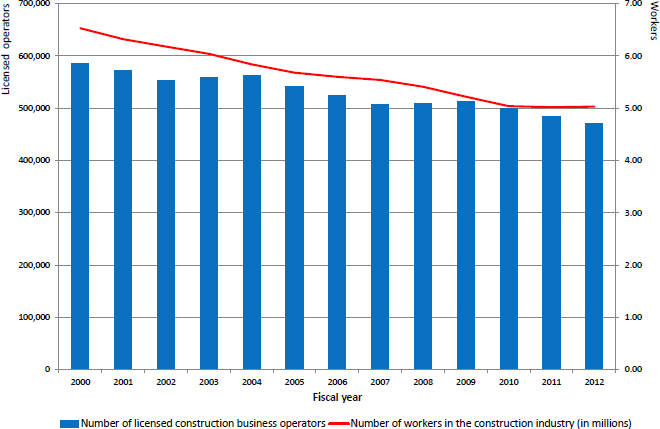The government of Prime Minister Shinzo Abe is promoting the empowerment of women as one of the pillars of its growth strategy. In this article, I would like to focus on efforts being made in the construction industry to secure their workforce by utilizing women.
Construction industry faced with a worker shortage
The number of licensed construction business operators in Japan decreased by more than 110,000 between FY2000 and FY2012. In keeping with this, the number of workers in the construction industry dropped by more than 1.5 million (figure. 1). Factors behind this include the aging of workers and a decrease in the number of young workers resulting from cutbacks on the hiring of new graduates in the past and an increasing resignation rate. Demand for construction work is on the rise particularly as preparations move into high gear for the 2020 Summer Olympic Games in Tokyo or for other reasons. However, faced with a serious workforce shortage, the construction industry may not have the sufficient supply capacity to meet the demand. Konno (2015) showed that a shortage of construction workers could cause failure of bidding on public construction works or force relative newcomers in the industry to discontinue business.

As part of their efforts to address the problem of workforce shortage, the Ministry of Land, Infrastructure, Transport and Tourism (MLIT) and five industry organizations—i.e., the Japan Federation of Construction Contractors (JFCC), the National General Contractors Association of Japan, All-Japan Smaller Construction Contractors Association, Kensenren (federation of specialized construction contractors), and the National Federation of Construction Contractors—have been promoting the greater utilization of women as a workforce.
Action plan for making the construction industry more empowering for women
In August 2014, MLIT and the five construction industry organizations put together an action plan aimed at making the construction industry more empowering for women. It calls for doubling the number of female engineers and building technicians within five years. This is meant to raise the proportion of women in such professions to 6%, the highest level seen to date.
The action plan is built on four pillars: 1) doubling the number of women entering the construction workforce; 2) creating a work environment that allows women to continue their career as they go through different life stages; 3) providing an environment for women that will enable them to take a more active role and further improve their skills; and 4) dissemination of information on successful women working in the construction industry.
MLIT has been trying out model construction projects designed to encourage the hiring of female engineers and promote efforts to make construction worksites more hospitable to women, for instance, by providing them with separate toilets and changing rooms. MLIT's Tohoku Regional Bureau designated a bridge construction project in Higashine, Yamagata prefecture, as one of such model projects, whereby the appointment of a female onsite engineer was made a prerequisite for participation in the bidding. Likewise, MLIT's Kyushu Regional Bureau introduced a model project in which the successful bidder will be required to have a woman as a "chief engineer" or "managing engineer" as defined under the Construction Business Act at the worksite (Tanigawa (2014)).
Improving the construction workplace to facilitate female participation will lead to improvement in the overall workplace environment for both men and women as well as to changes in people's mindset, which in turn will encourage more women to work and pursue a successful career in the construction industry, thereby creating a virtuous cycle. Meanwhile, Konno (2014a, 2014b) showed that improvement in the workplace environment also contributes to the business continuity of construction companies, suggesting the likelihood of having a significant positive impact on their management.
"Nadeshiko" is the keyword
Apart from those discussed above, JFCC launched a registration system for female construction workers' teams dubbed as "Nadeshiko construction teams." Named after a flower that personifies an idealized Japanese woman, a Nadeshiko construction team is formed by female engineers and building technicians working on the same construction project and can be registered as such only when women's presence at the worksite is significant in terms of their number or the roles they play. In addition to prompting improvements in the workplace environment for women, the registration system also has been playing a role in disseminating information on successful women in the construction industry. According to JFCC's list released on July 2, 2015, a total of 38 applications had been filed for registration as of the end of June 2015 (figure. 2).

In a similar effort, the Ministry of Economy, Trade and Industry (METI) and the Tokyo Stock Exchange (TSE) jointly launched a program to select companies with excellent practice in promoting women's participation and publicize their stocks as "Nadeshiko Brand" stocks. Selections are made from among the companies listed on the TSE's first section based on an industry-by-industry basis. First, they are evaluated and scored for their support measures designed to help women to: 1) succeed in their career and 2) achieve a work-life balance. Those that received high scores would then be further assessed for their business performance to be selected for Nadeshiko Brand designation.
From the viewpoint of investors focusing on growth in corporate value over the medium- to long-term or in socially responsible companies, the designation of Nadeshiko Brand stocks helps identify good stocks to invest in by publicizing the companies with excellent practice in promoting women's participation. This program can help promote investment in companies making good use of women's talents. As such, it is also hoped that companies looking for funds and investors will be prompted to enhance their utilization of women.
| Name of company | FY2012 | FY2013 | FY2014 |
|---|---|---|---|
| Daiwa House Industry Co., Ltd. | ♦ | ||
| Sekisui House, Ltd. | ♦ | ♦ | |
| Source: Created by the author based on the list of Nadeshiko Brand stocks in FY2014 released by METI and TSE. | |||
Nadeshiko Brand stocks have been selected every year since FY2012 and the construction industry has had two companies selected as such in the past three rounds (Table 1). These two companies are highly evaluated for their efforts to develop and enhance the talents of female candidates for managerial positions and/or initiatives to promote work-life balance.
Conclusion
In this article, I introduced a series of initiatives taken forward to date to promote the harnessing of women's talents, focusing on the construction industry. They are followed by many more new efforts, as exemplified by MLIT's announcement in June 2015 of yet another program, under which the ministry will subsidize selected local network initiatives to support women working in the construction industry.
Meanwhile, a recent survey of construction companies concerning the hiring of new employees and the adoption of information and communications technologies (ICTs) found that the smaller the company size is, the fewer the number of female and/or young engineers are hired (Daily Engineering & Construction News, June 30, 2015). Thus, the major challenge ahead is how to make the range of pro-women initiatives—those that are being undertaken by large construction companies—spread to smaller ones. Also, as aforementioned, empirical studies suggest that improvement in the workplace environment has a positive impact on the business continuity of construction companies. It is thus important for companies to recognize problems in the workplace environment as a matter that concerns the management of the entire business—not as a matter of the management of employees—and work to improve the situation based on that perception.


